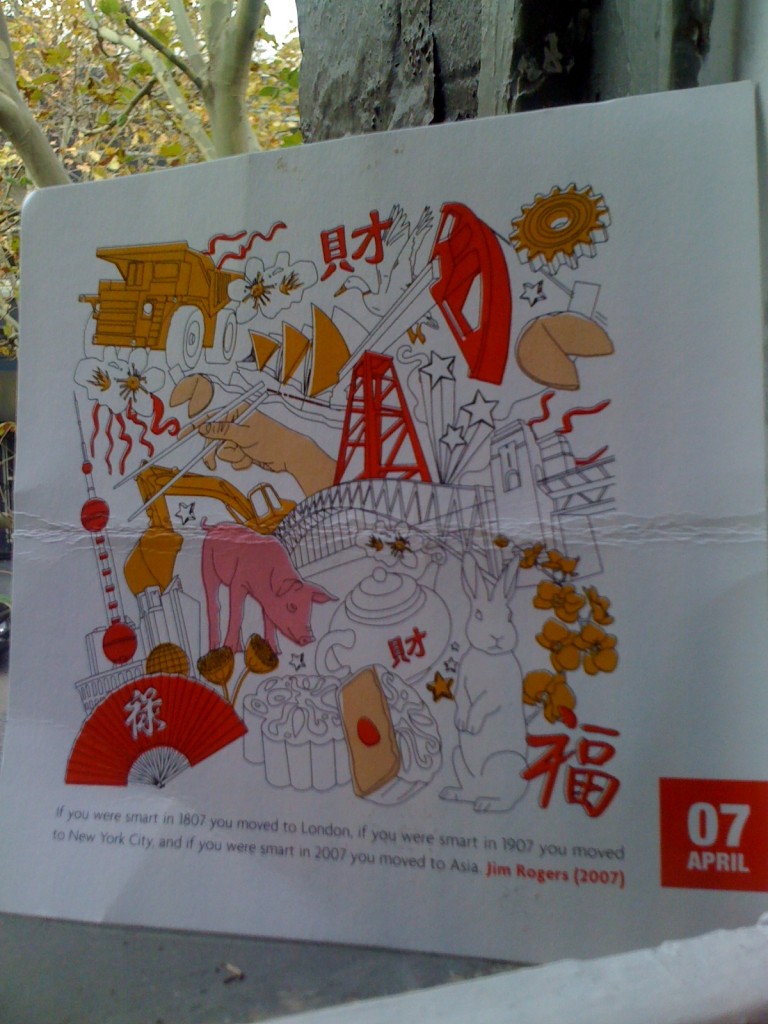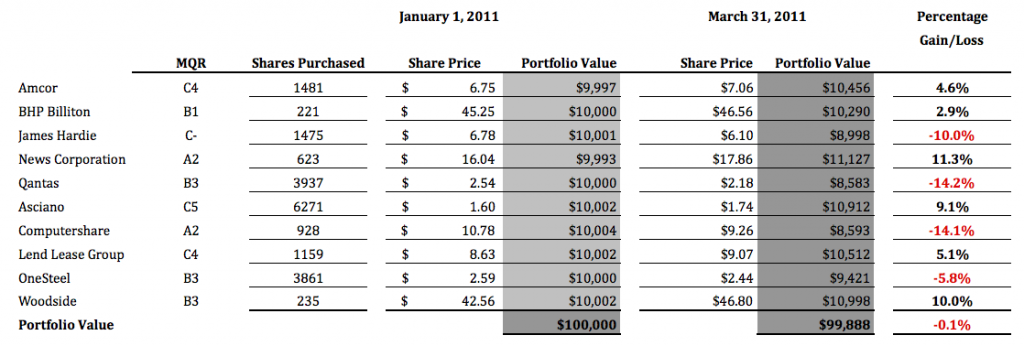Value.able
-
Is Oroton Australia’s best retailer?
Roger Montgomery
April 12, 2011
Oroton, JB Hi-Fi, The Reject Shop, Woolworths, Nick Scali, Cash Converters. If you have seen me on Sky Business or visited my YouTube channel recently, these names will be familiar. David Jones, Country Road, Harvey Norman, Myer, Super Retail Group (think Super Cheap Auto), Strathfield Group (Strathfield Car Radios), Noni B and Kathmandu also spring to mind, albeit for different reasons.
As a business, retailers are relatively easy to understand. The best managers are easy to spot (think Oroton’s Sally MacDonald) and it is also easy to separate the businesses with earnings power from those without (compare JB Hi-Fi and Harvey Norman).
But generally speaking even the best retailers may not be companies you want to hold forever. Why? Because they quickly reach saturation and so must constantly reinvent themselves.
Barriers to entry are low. There are always new concepts with young, intelligent and energetic entrepreneurs eager to develop a new brand and offering. Big red SALE signs are replacing mannequins as permanent window fixtures in Australian shop fronts, driving down revenue and margins. And for those who choose to defend brand value, sales revenue is also often sacrificed.
Then there’s the twin-speed economy, a string of natural disasters, soaring oil prices, growing personal savings, higher interest rates, Australia’s small population and one that is increasingly adept at shopping online for a getter price. Hands up who wants to be a retailer?
Retailers are attractive businesses – at the right price and the right stage in their life cycle. So, in retailing, who is Australia’s good, bad and just plain ugly?
Remember, these comments are not recommendations. Conduct your own independent research and seek and take professional personal advice.
Harvey Norman
ASX:HVN, MQR: A3, MOS: -19%A decade ago Gerry’s retail giant earned $105 million profit on $484 of equity that we put in and left in the business. That’s a return of around 19 per cent. Fast-forward to 2010 and we’ve put in another $117 million and retained an additional $1.5 billion. Despite this tripling of our commitment, however, profits have little more than doubled to $236 million. Return on equity has fallen by a third and is now about 12%. One decade of operating and the intrinsic value of Harvey Norman has barely changed. HVN is a mature business, but be warned… Harvey Norman is what JB Hi-Fi and The Reject Shop would see if they used a telescope to look forward through time.
OrotonGroup Limited
ASX:ORL, MQR: A1, MOS: -21%Sally MacDonald is a brilliant retailer. I highly recommend watching this interview – click here. Sally took over Oroton in 2006. In just five years she has cut loss making stores and brands, sliced overheads, improved both the quality and diversity of the range. The result? Surging revenues and return on equity in 2010 of circa 85 per cent. Try getting that in a bank account or even a term deposit! Asia offers even brighter prospects for Oroton while their product offering is sufficiently attractive and appealing that the company has the ability to weather the retail storm and protect its brand.
Woolworths Limited
ASX: WOW, MQR: B1, MOS: -17%You don’t get any bigger than Woolworths (its one of the 20 largest retailers on the planet!). It has a utility-like grip on consumers only, with earnings power that would put any utility to shame. The latter can be seen in the near 30% annualised increase in intrinsic value. Competitive position and size means suppliers and customers fund the company’s inventory. Challenges included professed legislative changes to poker machine usage (WOW is the largest owner of poker machines and any drag in revenue will have an exponential impact on profits), and the rollout of a competitor to Bunnings.
David Jones Limited
ASX: DJS, MQR: A2, MOS: -35%A beautiful shop makes not a beautiful business. I remember when David Jones floated. Shoppers who enjoyed the ‘David Jones’ experience and were loyal to the brand bought shares with the same enthusiasm as scouring the shoe department at the Boxing Day sales. Since 2007 DJS has reduced its Net Debt/Equity ratio from 108 per cent to just under 12 per cent. We are yet to see if Paul Zahra can lead DJs with the same stewardship as former CEO Mark McInnes but as far as department stores can possibly be attractive long-term investments, DJs isn’t it.
Myer
ASX: MYR, MQR: B1, MOS: -27%In 2009, following the release of that gleaming My Prospectus, I wrote:
“With all the relevant data to value the business now available and using the pro-forma accounts supplied in the prospectus, I value the company at between $2.67 and $2.78, substantially below the $3.90 to $4.90 being requested [by the vendors]. It appears to me that the float favours existing shareholders rather than new investors.”
My 2011 forecast value for Myer is just over $2. According to My Value.able Calculations, Myer will be worth less in 2013 than the price at which it listed in September 2010. If competitors like David Jones, Just Jeans, Kmart, Target, Big W, JB Hi-Fi, Fantastic Furniture, Captain Snooze, Sleep City, Harvey Norman, Nick Scali and Coco Republic were removed, Myer may just do alright.
Noni B
ASX: NBL, MQR: A2, MOS: -51%Noni B’s intrinsic value is the same as when Alan Kindl floated the company in 2000 (the family retained a 40% shareholding). Return on Equity hasn’t changed either. Shares on issue however have increased 50 per cent yet profits have remained relatively unchanged.
Kathmandu Holdings Limited
ASX: KMD, MQR: A3, MOS: -56%Sixty per cent of Kathmandu’s revenues are generated in the second half of the year. Will weather patterns continue to feed this trend? I sense premature excitement following the implementation of KMD’s newly installed intranet. The system may streamline store-to-store communications, reducing costs and creating inventory-related efficiencies for the 90-store chain, however what’s stopping a competitor replicating the same out-of-the-box system?
Fantastic Furniture
ASX: FAN, MQR: A3, MOS: -24%Al-ways Fan-tas-tic! Once upon a time it was. Low barriers to entry are seeing online retro furniture suppliers like Milan Direct and Matt Blatt are forcing Fantastic and other traditional players to reinvent the way they display, price and stock inventory.
Billabong
ASX: BBG, MQR: A3, MOS: -49%Billabong’s customers are highly fickle, trend conscious and anti-establishment. Like Mambo, as one of my team told me, Billabong is “so 1999 Rog”. Apparently Noosa Longboards t-shirts fall into the “cool” category, now. Groovy!
Eighty per cent of Billabong’s revenues are derived from offshore. Every one-cent rise in the Australian dollar has a half percent negative impact on net profits. Fans of the trader Jim Rogers believe the AUD could rise to USD$1.40! Then there’s the 44 stores affected by Japan’s earthquake (18 remain closed) and another three in the Christchurch earthquake.
Country Road
ASX: CTY, MQR: A3, MOS: -63%).Like the quality of their clothing, Country Road’s MQR has been erratic. So too has its value. Debt is low however cash flow is not attractive. Very expensive.
Cash Convertors
ASX: CCV, MQR: A2, MOS: +26%.Value.able Graduates Manny and Ray H nominated CCV as their A1 stock to watch in 2011. Whilst its not yet an A1, Cash Convertors is a niche business with bight prospects for intrinsic value growth.
Other retailers to watch
I have spoken about JB Hi-Fi, Nick Scali and The Reject Shop many times on Peter Switzer’s Switzer TV and Your Money Your Call on the Sky Business Channel. Go to youtube.com/rogerjmontgomery and type “retail”, “JBH”, “TRS” or “reject” into the Search box to watch the latest videos.
In October 2009 the RBA released the following statistics:
16 million. The number of credit cards in circulation in Australia;
$3,141. The average monthly Australian credit card account balance;
US$56,000. The average mortgage, credit card and personal loan debt of every man, woman and child in Australia;
$1.2 trillion. The total Australian mortgage, credit card and personal loan debt;
$19.189 billion. The amount spent on credit and charge cards in October 2009.Clearly we are all shoppers… what are your experiences? Who do you see as the next king of Australia’s retail landscape?
Posted by Roger Montgomery, author and fund manager, 12 April 2011.
by Roger Montgomery Posted in Companies, Consumer discretionary, Insightful Insights, Investing Education, Value.able.
-
Is that Jim Rogers’ copy of Value.able?
Roger Montgomery
April 8, 2011
I’ve been following and chatting to Jim Rogers for many, many years. And, if your pockets are deep enough to ride out the inevitable bumps (“nothing goes up in a straight line Roger”), his commodity calls have been on the money.
Last night I was delighted to catch up with him again, after being invited by CBA to celebrate the first birthday of their Institutional Equities business (the invitation (picture below) read “If you were smart in 1807 you moved to London, if you were smart in 1907 you moved to New York City, and if you were smart in 2007 you moved to Asia“, Jim Rogers 2007). I was impressed by how many of my friends in the funds management industry have employed the Institutional Equities desk of CBA. They are obviously not restricting their excellent service to me!
Jim arrived and I had the opportunity to catch up before he went on to speak to the audience. For those who missed it, he remains extremely bullish on commodities and in particular Cotton, Sugar, Oil and Gold. The audience were perhaps most in agreement with a bullish view on wheat and while this wasn’t discussed, I can tell you the expansion of deserts in China and the depletion of water reserves there will cause a fundamental step-change in the world’s agricultural markets and the price of food.
But if you really want to get a sense of how bullish Jim is try this on for size: Oil = $200/barrel or more (see my January 2011 Post), Gold $2000/ounce (January 2011 Post) sometime in the next decade and the Aussie dollar? Wait for it…..US$1.40!!!! Jim didin’t say it in so many words, but it was being whispered between the salt and pepper prawns, lime and coconut marshmallows, and for the late night revellers, a 2001 Noble One.
As you can see Jim was delighted to receive a personally dedicated copy of Value.able to read on the flight back to Singapore. I hope that he gets as much out of it as I have from his.
Posted by Roger Montgomery, author and fund manager, 8 April 2011.
by Roger Montgomery Posted in Value.able.
- 96 Comments
- save this article
- POSTED IN Value.able
-
Another warning Roger?
Roger Montgomery
April 8, 2011
 Last night on Peter’s Switzer TV I shared five stocks moving up the Montgomery Quality Ratings (MQR) – B3 to A3, C4 to B3, A4 to A3, C5 to A2 and A4 to A2.
Last night on Peter’s Switzer TV I shared five stocks moving up the Montgomery Quality Ratings (MQR) – B3 to A3, C4 to B3, A4 to A3, C5 to A2 and A4 to A2.There are about thirty-seven ratios that contribute to the Montgomery Quality Rating. Like the Value.able method for valuing businesses, the MQR is my own unique system of assessing the quality and performance of businesses. Its objective is to weed out those with a high risk of catastrophe and highlight those with a very low risk.
I also spoke about Zicom, a very thinly traded micro-cap that we began buying for the Fund at $0.32, up to $0.42. Yesterday Zicom closed at $0.52 – my estimate of its Value.able intrinsic value.
If you read my ValueLine column for Alan’s Eureka Report on Wednesday evening you will recognise the following warning:
A WARNING FROM ROGER MONTGOMERY: The subject of today’s column is a thinly traded microcap in which I have bought shares because it meets my criteria. It may not meet yours. It is therefore information that is general in nature and NOT a recommendation or a solicitation to deal in any security. The information is provided for educational purposes only and your personal financial circumstances have not been taken into account. That is why you must also seek and take personal professional advice before dealing in any securities. Buying shares in this company without conducting your own research is irresponsible. Buying shares in this company will drive the price up, which will benefit me more than you. The higher the price you pay the lower your return. If the share price rises well beyond my estimate of intrinsic value, I could sell my shares. A share price that rises beyond my estimate of intrinsic value is one of my triggers for selling. I have no ability to predict share prices and despite a margin of safety being estimated, the share price could halve tomorrow or worse. There are serious and significant risks in investing. Be sure to familiarise yourself with these risks before buying or selling any security. Further, my intrinsic value could change tomorrow, if new information comes to light or I simply change my view about the prospects of a company. This could be another trigger for me to sell. Value investing requires patience. You must seek and take personal professional advice and perform your own research.
I reiterated these same concerns last night with Peter (and early last year I wrote a blog post specifically about the problem).
With those warnings in mind, here are the highlights from Peter’s show.
What stocks are on your ‘Improving MQRs’ watchlist? Thank you in advance for sharing your ideas with our Value.able community.
Posted by Roger Montgomery, author and fund manager, 8 April 2010.
by Roger Montgomery Posted in Companies, Insightful Insights, Investing Education, Value.able.
-
Will David beat Goliath?
Roger Montgomery
April 6, 2011
 I am deviating from my regular style of post, handing over the stage to Value.able Graduate Scott T. Scott T has taken up a fight with conventional investing by tracking the performance of a typical and published ‘institutional-style’ portfolio against a portfolio of companies that receive my highest Montgomery Quality Ratings. I reckon in the long run the A1/A2 portfolio will win, but let’s not get ahead of ourselves.
I am deviating from my regular style of post, handing over the stage to Value.able Graduate Scott T. Scott T has taken up a fight with conventional investing by tracking the performance of a typical and published ‘institutional-style’ portfolio against a portfolio of companies that receive my highest Montgomery Quality Ratings. I reckon in the long run the A1/A2 portfolio will win, but let’s not get ahead of ourselves.Over to you Scott T…
In December 2010, a large international institution released their “Top 10 stockpicks for 2011”. Click here to read the original story.
I thought it would be interesting to compare the performance of these suggestions against an A1 and A2 Montgomery portfolio.
So I imagined this scenario…
Twin brothers in there 30’s each inherited $100,000 from their parent’s estate. One was a conservative middle manager in the public service; he had little interest in the stock market or super funds and the like, so he decided to go to an internationally renowned, well-credentialed and highly respected firm to gain specific advice. Goldman Sachs advised him of their top ten stocks for 2011, so he decided to achieve diversification by investing $10,000 in each of the ten stocks he had been told about.
His twin had a small accounting practice in a regional Queensland and was a keen stock market investor. Specifically he was a student of the Value Investing method, and liked to think of himself as a Value.able Graduate. He too thought diversification would be a suitable strategy so decided to invest $10,000 in each of 10 stocks that were A1 or A2 MQR businesses and that were selling for as big a discount to his estimate of Value.able intrinsic value as he could find.
For this 12-month exercise, running for a calendar year, we shall assume that neither brother is able to trade their position. One brother has no inclination to, and his regional twin is fully invested, and more inclined to hold long anyway.
For the companies who have declared dividends in this quarter, most are now trading ex-dividend, but only 2 or 3 have actually paid. Dividends will be picked up in Q2 and Q4 of this study.
Now after just 3 months let’s look at the how the two portfolios have performed…
Institutional Bank Top 10 Picks for 2011
Montgomery Quality Rated (MQR) A1 and A2 Companies
We will visit the brothers again in 3 months on 30/6/2011 to see how they are fairing.
All the best
Scott T
How has your Value.able portfolio performed compared to the ASX 200 All Ords?
Posted by Roger Montgomery, author and fund manager, 6 April 2011.
by Roger Montgomery Posted in Companies, Insightful Insights, Investing Education, Value.able.
-
Why idolise the iPad2?
Roger Montgomery
March 29, 2011
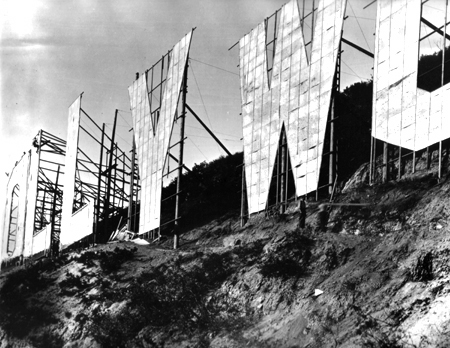 It’s an amazing story… Man creates computer. Man overcomplicates computer. Man strips back computer and creates a brand that has revolutionised the way we are entertained.
It’s an amazing story… Man creates computer. Man overcomplicates computer. Man strips back computer and creates a brand that has revolutionised the way we are entertained.Did you know Apple has sold over 300 million iPods and iPhones over the past decade? That’s 300,000,000 products. According to the World Bank, in 2009 the world’s population stood at 6,775,235,741. The World Bank also notes that 80 per cent of the world’s population lives on less than $10 per day. Of the remainder, every 4th man, woman and child has purchased an Apple products in the last decade. Not a bad competitive advantage, (postscript: but perhaps not a sustainable one?)
Apple is also infiltrating the way we work. The Montgomery office is all Mac (and for your information, we have never had to call an IT professional to fix anything). Our iPhones are synced with our iMacs and our MacBooks synced with our iPhones.
You have heard the stories of Apple fans setting up camp on the footpath outside Apple’s flagship store on Sydney’s George Street. Australians don’t do that for coal or iron ore.
And don’t forget the accessories market. There’s no special concessions for development partners. Privately held companies that manufacture the sleeves, cases and connectivity devices that enhance our Apple experience don’t get hold of new devices until we do – on launch day.
Apple has the X-factor. Its product is unique. Its experience is unique and there is an almost religious fervour toward the brand. Competitors don’t stand a chance. The result? High, durable rates of return on equity and a rising Value.able intrinsic valuation – an A1 business.
Return on Equity is just one of dozens of metrics I uses to produce the Montgomery Quality Rating (MQR). Re-read Chapter Eleven, Step C on page 188 of Value.able for the Value.able ROE calculation.
Who is the Aussie equivalent? The Australian market may be much smaller than the US, but there are a handful of extraordinary businesses, A1 businesses. And its worth finding tem. They may not be listed yet. They may not even have launched yet…
Posted by Roger Montgomery, author and fund manager, 29 March 2011.
Postscript: The data used to calculate intrinsic value is available here: https://www.apple.com/investor/
by Roger Montgomery Posted in Companies, Investing Education, Value.able.
-
When to sell? Matrix and other adventures in Value.able Investing
Roger Montgomery
March 18, 2011
In August 2010 Matrix Composites & Engineering, when we first began commenting on the company, was trading around $2.90. Thirty days later the share price was at $4.48. Today MCE is trading at just over $9.00 and has a market capitalisation of more than half a billion dollars. It’s no longer just a little engineering business. Like the Perth industrial precinct of Malaga in which its headquarters are based, MCE is growing rapidly (according to Wikipedia there are currently 2409 businesses with a workforce of over 12,000 people in Malaga. The 2006 census listed only 28 people living in the suburb).
But has MCE’s share price risen beyond what the business is actually worth?
Stock market participants are very good at telling us what we should buy and when. When it comes to selling, it seems silence is the golden rule.
If you receive broker research, take out a report and turn to the very back page – the one beyond the analyst’s financial model. You will often find a table that lists every company covered by that broker’s research department. Now look to the right of each stock listed. What do you notice?
Buy… Buy… Hold… Buy… Buy… Accumulate… Hold…
What about sell?
There aren’t many companies in Australia worthy of a buy-and-hold-forever approach. And if you have invested in a company with a previous BUY recommendation, the luxury of a subsequent Ceasing Coverage announcement by the analyst is not helpful.
So then, when should you sell? It is a question I have been asked, to be honest, I can’t remember how many times. Because I have been asked so many times, it’s a question I answered in Chapter 13 of Value.able – a chapter entitled Getting Out.
Value.able Graduates will recognise a sell opportunity. Yes, it is an opportunity. Fail to sell shares and you could eventually lose money.
Of course, any selling must be conducted with a certain amount of trepidation, particularly when capital gains tax consequences are considered. But not selling simply because of tax consequences is unwise.
We pay tax on our capital gains because we make a gain. Yes, its difficult handing over part of our investment success to the Tax Man for seemingly no contribution, but without success our bank balance would remain stagnant forever.
When then should you sell? In Value.able I advocate five reasons. For now I would like to share with you a possible reason. Based on any of the other reasons I may be selling Matrix so make sure you understand this is a review based on one of five reasons.
Eventually share prices catch up to value. In some cases it can take ten years, but in the case of Matrix, it has taken far less time for the share price to approach intrinsic value.
One signal to sell any share is when the share prices rise well above intrinsic value.
There are no hard and fast rules around this. And don’t believe you can come up with a winning approach with a simple ‘sell when 20% above intrinsic value’ approach either.
What you MUST do is look at the future prospects. In particular, is the intrinsic value rising? I believe it is for Matrix (and I am not the only fund manager who does – you could ask my mate Chris too).
Here’s some of his observations: Risks associated with the timing of getting Matrix’s facility at Henderson up and running are mitigated by keeping Malaga open. And Malaga is producing more units now than it was only a few months ago. Matrix could also produce more units from Henderson than they have suggested (the plant is commissioned to produce 60 units per day) and I believe the cost savings will flow through much sooner than they say. Recall the company has indicated Henderson could save circa $13 million in labour, rent and transport costs (see below analyst comment). Excess build costs are now largely spent and if the company can ramp up to 70 units a day, HY12 revenue could double.
Why do I believe this? Because a recent site visit for analysts suggested it. As one analyst told me: “Production of macrospheres has started from Henderson with 7 of the 22 tumblers in operation. This is a good example of the labour savings to come as it’s now a largely automated process – there were only 3 people working v >20 on this process at Malaga.”
(Post Script: My own visit to WA at the weekend revealed a company capable of producing just over 100 units per day – Henderson + Malaga) Moreover, the sad events unfolding in Japan will force a rethink on Nuclear. If nuclear energy – recently hailed as a green solution to global warming – reverts to being a relic of an old world order, demand for oil will increase. Oil prices will rise. Deep sea drilling will be on everyone’s radar even more so.
And the risks? Well, one is pricing pressure from competitors. This is something that needs to be discussed with management, but preferably with customers!
Some Value.able Graduates may be reluctant to place too much emphasis on future valuations. Indeed I insist on a discount to current valuations. If it is your view that future valuations should be ignored, then you should sell.
Personally I believe one of my most important contributions to the principles of value investing is the idea of future valuations. Nobody was talking about them at the time I started mentioning 2011 and 2012 Value.able valuations and rates of growth. They are important because we want to buy businesses with bright prospects. And a company whose intrinsic value is rising “at a good clip” demonstrates those bright prospects.
If you have more faith and conviction that the business will be more valuable in one, two and three years time, you may be willing to hold on. On the basis of this ONE reason I am currently not rushing to sell Matrix (of course I may sell based on any of the other four reasons), however notwithstanding a change to our view (or one of the other four criteria for selling being met) I do hope for much lower prices (buy shares like you buy groceries…)
I cannot, and will not, tell you to sell or buy Matrix and I might ‘cease coverage’ at any time. As I have said many times here, do not use my comments to buy or sell shares. Do your own research and seek and take personal professional advice.
What I do want to encourage you to do is delve deeply into the company’s history, its management, their capabilities, recent announcements and any other valuable information you can acquire.
And in the spirit demonstrated by so many Value.able Graduates, feel free to share your findings here and build the value for all investors.
When the market values a company much more highly than its performance would warrant, it is time to reconsider your investment. Looking into the prospects for a business and its intrinsic value can help making premature decisions. Premature selling can have a very costly impact on portfolio performance not only because the share price may continue rising for a long time, but also because finding another cheap A1 to replace the one you have sold, is so difficult. At all times remember that my view could change tomorrow and I may not have time to report back here so do your own research and form your own opinions. Also keep in mind that we do not bet the farm on any one stock so even if MCE were to lose money for us (and we will get a few wrong) we won’t lose a lot.
Posted by Roger Montgomery, author and fund manager, 18 March 2011.
by Roger Montgomery Posted in Companies, Energy / Resources, Investing Education, Value.able.
-
How has my Switzer Christmas Stocking Selection performed?
Roger Montgomery
February 10, 2011
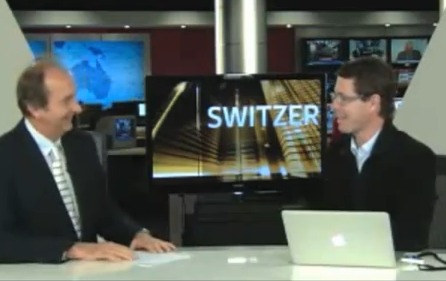 On the last show of 2010, Peter Switzer asked me to list six of my A1 businesses that, at the time, were displaying the largest margins of safety. Tonight Peter has invited me to join him once again to review how those six A1s have performed (and chat about Telstra’s result no doubt). Tune into the Sky Business Channel (602) from 7pm (Sydney time).
On the last show of 2010, Peter Switzer asked me to list six of my A1 businesses that, at the time, were displaying the largest margins of safety. Tonight Peter has invited me to join him once again to review how those six A1s have performed (and chat about Telstra’s result no doubt). Tune into the Sky Business Channel (602) from 7pm (Sydney time).Here’s the article/transcript from that appearance.
Click here to watch the latest interview and discover how my A1 picks performed.
A1 stocks are the cream of the crop, but how do you know which stocks measure up? To find out, Roger Montgomery joins Peter Switzer on his Sky News Business Channel program – SWITZER.
Montgomery explains he classes companies from A1 down to C5.
“A1 is a business, I think, that has the absolute lowest probability of what I call a liquidity event – the lowest chance of having to raise capital, the lowest chance of needing to borrow more money, the lowest chance of defaulting on any debt that it has, breaching a banking covenant or a debt covenant, the lowest chance of needing money or going bust,” he says.
Montgomery says he’s interested in consistency of performance – A1s that he think will be A1 in the next 12 months.
“I’m looking for the companies that have been consistently A1s or A2s over a longer period of time,” he says. “They’re the ones that I think are most likely to be next year as well.”
Montgomery stresses that it’s important to diversify and get professional advice.
“Make sure you don’t bet the farm on any one company,” he says. “That’s why you need personal professional advice, because you’ve got to make sure that you’re doing the right thing for you and everybody has different risk tolerances.”
Montgomery’s A1 stocks
Platinum Asset Management – he says this is an “obvious A1 – a great performer, has no need for debt, pays all of its cash out.” The company is trading at about its intrinsic value, so it’s not a bargain, but it’s good quality. The intrinsic value is expected to rise around 14 per cent over three years.
Cochlear – “It’s been an A1 for years,” he says adding that its current share price is not cheap enough. Its intrinsic value is expected to rise around 13 per cent over the next three years.
Blackmores – “Expensive at the moment,” he says. “The intrinsic value is only expected to rise about five per cent over the next three years.”
Real Estate.com – “It’s expensive again – it’s trading at about 15 per cent above its intrinsic value.” The intrinsic value is expected to rise 15 per cent in a year. Its intrinsic value is forecast to rise by about 15 per cent a year. “In a year’s time, its intrinsic value will be its current price.”
M2 Telecommunications – This company is trading at a 10 per cent premium to its intrinsic value, Montgomery says. “It’s not cheap, but its intrinsic value is forecast to rise by eleven and a half per cent.”
Mineral Resources – This is a mining services business and is trading around its intrinsic value. The intrinsic values are forecast to increase by around 30 per cent a year over the next three years – “So that’s not bad.”
DWS Advanced – Montgomery says this IT services business is trading at a three per cent discount to intrinsic value and its intrinsic value is expected to rise by about 13 per cent.
Centrebet – Montgomery explains that people tell him there’s not many competitive advantages with the company because barriers to entry to the industry are low. “The owners of the licenses for these things would say they disagree – barriers to entry are quite high,” he says. Centrebet is at a six per cent discount to intrinsic value and it’s forecast to rise around five per cent a year, Montgomery says.
ARB – “Trading at about 11 per cent discount to its intrinsic value. Forecast intrinsic value is going to rise by about three-and-a-half per cent,” he says.
Oroton – “There’s been some talk about the CEO selling shares. The issue is I’ve bought shares from CEOs and founders who’ve sold shares and the share price has gone up a lot since then. I’ve also seen situations where the CEO has sold and that’s been the best time to have sold.”
Montgomery says there hasn’t been research to show CEOs selling shares indicated anything, but there has been research to suggest CEOs buying shares may indicate something. Oroton is trading at a 13 per cent discount to intrinsic value and is expected to rise 13 per cent per annum.
Companies trading at premiums to their intrinsic value
Reckon
Thorn Group
GUD Holdings
Fleetwood
Wotif
Monadelphous
The intrinsic value on these companies are rising anywhere from six per cent to around 17 per cent per year over the next three years, Montgomery says.
Montgomery says it’s important to do further research on the companies – “you can’t just go out and buy them – some of them, as I’ve pointed out, are expensive, so I wouldn’t be buying them. Some of them are A1s but that doesn’t mean that they’re amazing businesses and they’re the best businesses to buy. They’re the least chance of having a liquidity event.”
Companies trading at discount to intrinsic value
Montgomery explains he isn’t predicting share price; he’s valuing the company.
“Valuing a company is different to predicting where the share price is going to go”.
In descending order – biggest discount to smallest discount:
Matrix
Composite and Engineering
Nick Scali
JB Hi-Fi
Oroton
ARB
Centrebet
DWS
“We’ll come back in the New Year, we’ll have a look at how the index has gone, and we’ll have a look at how that little group of companies has performed.”
Important information: This content has been prepared by www.switzer.com.au without taking account of the objectives, financial situation or needs of any particular individual. It does not constitute formal advice. For this reason, any individual should, before acting, consider the appropriateness of the information, having regard to the individual’s objectives, financial situation and needs and, if necessary, seek and take appropriate professional advice.
Posted by Roger Montgomery, author and fund manager, 10 February 2010.
by Roger Montgomery Posted in Insightful Insights, Investing Education, Value.able.
-
Will your portfolio repeat its 2011 performance?
Roger Montgomery
February 2, 2011
 If you are new to my stock market Insights blog, welcome. And to the Value.able community, thank you for your many comments and encouraging words. It gives me great encouragement and motivates me to hear how your investing and returns have improved as a result of reading Value.able and the collection of comments posted by Graduates here at my blog. Thank you also for spreading the word and purchasing additional copies for family and friends.
If you are new to my stock market Insights blog, welcome. And to the Value.able community, thank you for your many comments and encouraging words. It gives me great encouragement and motivates me to hear how your investing and returns have improved as a result of reading Value.able and the collection of comments posted by Graduates here at my blog. Thank you also for spreading the word and purchasing additional copies for family and friends.Taking a look back over the stocks we discussed last year, it appears the Value.able approach to investing in the highest quality businesses, with a true margin of safety, has been doing quite well.
In addition to the blog, I also wrote about many of the stocks that achieve an A1 Montgomery Quality Rating (MQG) in my Value.able stocks for Money magazine over the last six months of 2010.
The stocks are listed in the table below. The column titled ‘Gain’ demonstrates you can do well without exposing yourself to lots of risk – for example the risk that is inherent in speculative stocks.
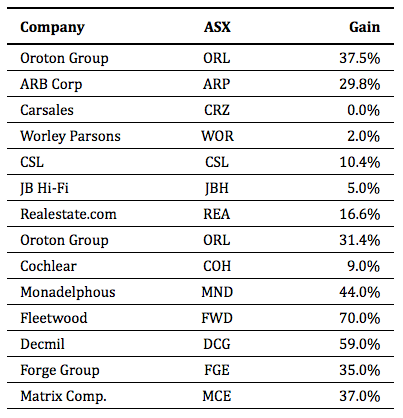
The returns exclude the dividends received, which would obviously boost results materially. The correct comparison therefore is the All Ords price index rather than the All Ordinaries Accumulation Index. Since 30 June 2010 the All Ordinaries has risen 12%. That is a stark contrast to many of the returns produced by the high quality businesses listed above.
The returns stand even higher above the Index when the selection is ranked by those that I regarded as offering the greatest margin of safety at the time the stock was mentioned: Oroton (up 37.5%), ARB Corporation (up 29.8%), JB Hi-Fi (bought and then sold the next month (up 5%), Monadelphous, Forge, Decmil and Matrix (up 44%, up 59%, up 35%, and up 37% respectively). The average, six month, price-only return of these businesses is 34.8%. And some of these A1 businesses, a margin of safety still exists.
If you are new to value investing you will, when searching around, find many commentators, portfolio managers and investors who may disparage value investing generally. They may question the method of calculating intrinsic value or even dismiss the valuations produced, but quite seriously, the proof is in the eating. And the returns offered have been nothing short of mouth watering.
But six months is NOT enough to hang your hat on, as Tony and Adam recently pointed out on my Facebook page. So if you have been an investor in any of these companies, following a conversation with your adviser of course, remember that the change in price over a year or two shouldn’t excite or concern you. It’s the change ahead in the Value.able intrinsic value of the company that matters.
If you haven’t already purchased your copy of Value.able, I commend it to you. It will change the way you think about investing in the stock market for the better, and as the many independent comments elsewhere here on the blog can attest, it may also materially improve your results. Value.able is available exclusively at www.rogermontgomery.com
Posted Roger Montgomery, author and fund manager, 2 February 2011.
by Roger Montgomery Posted in Companies, Insightful Insights, Investing Education, Value.able.
-
After some extra help with your holiday homework?
Roger Montgomery
January 6, 2011
 Happy new year! I trust you had a safe, peaceful and Happy Christmas.
Happy new year! I trust you had a safe, peaceful and Happy Christmas.To the Value.able Graduates, thank you for sharing your knowledge and taking the time to help the Undergrads with their holiday homework.
If you are seeking a little extra guidance, this Masterclass video I recorded for Alan’s Eureka Report may just do the trick. Think of it as Value.able‘s Chapter 11, Steps A-D and Steps 1-4, live.
If you have not already secured your copy of Value.able and want to kick 2011 off the Value.able way, go to www.RogerMontgomery.com. The First Edition sold out in just 14 weeks and with so many private and professional investors now buying multiple copies for friends and family, the Second Edition is set to sell out just as quickly. Don’t waste another minute!
Posted by Roger Montgomery, 6 January 2011.
by Roger Montgomery Posted in Companies, Investing Education, Value.able.
-
Thank you and Happy Christmas
Roger Montgomery
December 23, 2010
I am delighted that, in 2010, so many investors have found Value.able useful. Many Graduates have said the Value.able approach to investing is at once easy to understand and rational. And according to John, Scott, Brian, Peter, Andy, Martin and Steve’s feedback, Value.able!
Merry Christmas Roger! And a big thankyou for writing your book.
It never ceases to amaze me just how few professional investors actually stick to a winning investment formula. I recently reviewed the portfolio holdings of many well known Australian Equity managed funds available through a major online broker and could not find one “leading” fund manager that only invested in stocks that would come anywhere near to passing the MQR (Montgomery Quality Rating) test. Virtually all major funds hold stocks that are low ROE, highly capital intensive and debt laden. Unfortunately, I was not surprised to see that many of these funds holding large positions in non-investment grade stocks proudly highlight their 5 star ratings from asset consultants.
Have a well-earned break and may 2011 be an in-value.able year for you and yours,
Warmest regards,
JohnMerry Christmas everybody! And to you Mr Montgomery, a massive thank you.
Thanks to your wonderful book, and your insightful and thought provoking articles, posts and appearances. My SMSF has had the best year ever (that’s with 10 years of history).
In a lack lustre sideways market I was able to pinpoint and cut out the dead wood from previous poor decisions, and focus on quality businesses trading at a big discount to IV.
The difference in fund performance is simply startling.
Again thank you, I hope to be able to shake your hand again in 2011.
All the best
Scott THi Adam & Roger, … I’m pleased I’m getting the hang of these valuations. I’ve bought a few other A1’s also, MCE, SWL (A3) & FGE on my research following your valuation criteria Roger, as well as JBH. I’m getting rid of some rubbish (AMP,BFG,VMG,BYL) & feel confident I’m replacing them with quality shares. Thanks so much for sharing Roger, my retirement looks a little more hopeful now following the devastation of the GFC.
Brian
Hi Roger, Thanks for writing the book and your diligence in keeping the blog up to date. You’ve made a massive contribution to my awareness and knowledge. The book has already been paid for hundreds of times over.
Cheers, Peter
Roger, Thanks for all the great insights over the last year. I really had no idea how blindly I had been investing prior to reading your book and this blog. I’m still learning but at least I know what I should be looking at now.
Thanks again
Andy
Hi Roger, Just wanted to thankyou for sharing your knowledge and insights with everyone, your book was amazing to say the least!!! I’ve made a return of close to 20% in less than 6 months and your Value.able book has paid itself off by more than 200 times!!! Now that is what I call ROE. I would like to wish you and your family a Merry Christmas and a happy new year. Thank you so much for an extremely valuable year, congrats and best wishes.
Regards,
Martin
Hi Roger, I see many comments on the blog congratulating you on your book, but they don’t actually say why it is great. So I have done a book review.
Regards,
Sapporo Steve
If you have not already secured your copy of Value.able and want to kick 2011 off the Value.able way, go to www.RogerMontgomery.com. The First Edition sold out in just 14 weeks and with so many private and professional investors now buying multiple copies for friends and family, the Second Edition is set to sell out just as quickly. Don’t waste another minute!To the Value.able Graduates, thank you for taking the time to share with me just how much you have been impacted by my book. I am delighted to hear your amazing stories of investing success and I am pleased we can sign off 2010 with such an extraordinary investment track record.
I wish you all a safe, peaceful and Happy Christmas and my sincere best wishes for 2011. I have always been enthralled by Caravaggio’s work. The Adoration was painted in 1609.
My office will close today and reopen on Monday 10 January. I will return in late January. My team will continue to publish your comments here at the blog, post new videos to my YouTube channel and reply to your emails. Most importantly, my website will continue to accept your Value.able orders and my distribution house is working through the holiday season.
Posted by Roger Montgomery, 23 December 2010
by Roger Montgomery Posted in Insightful Insights, Investing Education, Value.able.
